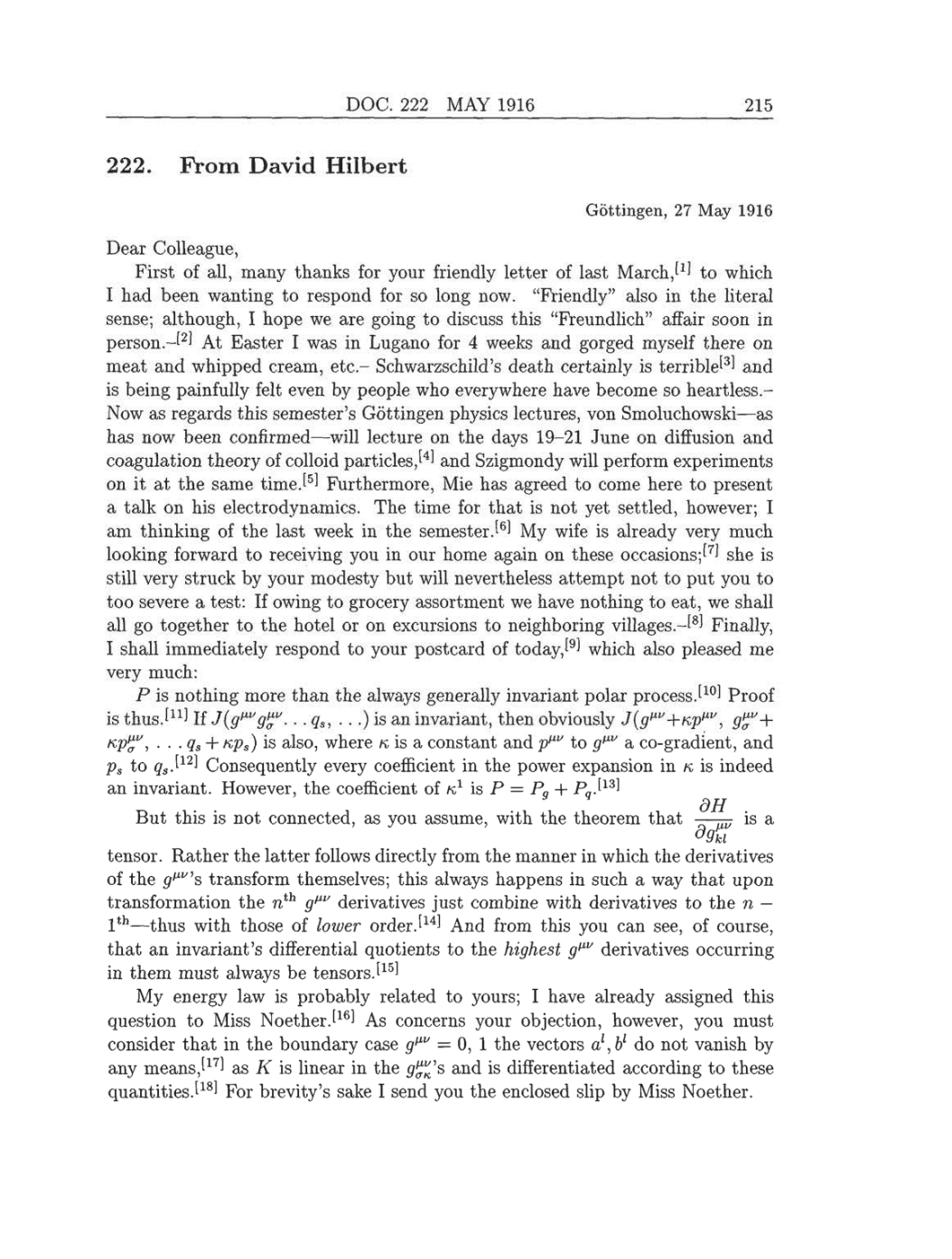DOC.
222 MAY 1916 215
222. From David Hilbert
Göttingen, 27
May
1916
Dear
Colleague,
First
of
all, many
thanks
for
your friendly
letter
of
last
March,[1]
to which
I
had
been
wanting
to
respond
for
so
long
now.
“Friendly”
also in
the literal
sense; although,
I
hope
we are going
to
discuss this “Freundlich” affair
soon
in
person.-[2]
At
Easter
I
was
in
Lugano
for
4
weeks
and
gorged myself
there
on
meat
and
whipped cream,
etc.- Schwarzschild’s
death
certainly
is terrible[3]
and
is
being painfully
felt
even
by people
who
everywhere
have become
so
heartless.-
Now
as
regards
this semester’s
Göttingen physics lectures,
von
Smoluchowski-as
has
now
been
confirmed-will
lecture
on
the
days
19-21
June
on
diffusion and
coagulation
theory of colloid
particles,[4]
and
Szigmondy
will
perform experiments
on
it at
the
same
time.[5]
Furthermore,
Mie
has
agreed
to
come
here
to
present
a
talk
on
his
electrodynamics.
The time
for
that
is
not
yet
settled, however; I
am
thinking
of
the last
week in
the
semester.[6]
My
wife
is
already very
much
looking
forward
to
receiving you
in
our
home
again on
these
occasions;[7]
she
is
still
very
struck
by your modesty
but
will
nevertheless
attempt
not to
put
you
to
too
severe a
test: If
owing
to
grocery
assortment
we
have
nothing
to
eat,
we
shall
all
go
together
to
the
hotel
or on
excursions to
neighboring
villages.-[8]
Finally,
I shall
immediately respond to your
postcard of
today,[9]
which also
pleased
me
very
much:
P
is nothing
more
than the
always generally
invariant
polar
process.[10]
Proof
is
thus.[11]
If
J(guvgouv...qs,
...)
is
an invariant,
then
obviously
J(guv
+
Kpuv,
gouv
+
kpouv,
...qs
+
Kps)
is
also,
where
k
is
a
constant and
puv
to
guv
a
co-gradient,
and
ps
to
qs.[12]
Consequently every
coefficient
in
the
power expansion
in
k
is
indeed
an
invariant.
However,
the
coefficient of
k1
is
P
=
Pg
+
Pq.[13]
But this
is
not
connected,
as
you assume,
with
the
theorem
that
dH/dgkluv
is
a
tensor.
Rather the latter
follows
directly
from
the
manner
in which
the
derivatives
of
the
guv,s
transform
themselves;
this
always happens
in such
a way
that
upon
transformation the
nth
guv
derivatives
just
combine with derivatives
to
the
n
-
1th-thus
with those of lower
order.[14]
And from this
you
can see,
of
course,
that
an
invariant’s differential
quotients
to
the
highest
guv
derivatives
occurring
in them must
always
be
tensors.[15]
My
energy
law
is
probably
related to
yours;
I have
already
assigned
this
question
to Miss
Noether.[16] As
concerns
your objection, however, you
must
consider
that
in
the
boundary
case
guv
=
0,
1
the
vectors
al,bl
do not vanish
by
any
means,[17] as
K
is
linear in the
gokuv's
and
is
differentiated
according
to these
quantities.[18]
For
brevity’s
sake
I
send
you
the
enclosed
slip by
Miss
Noether.
